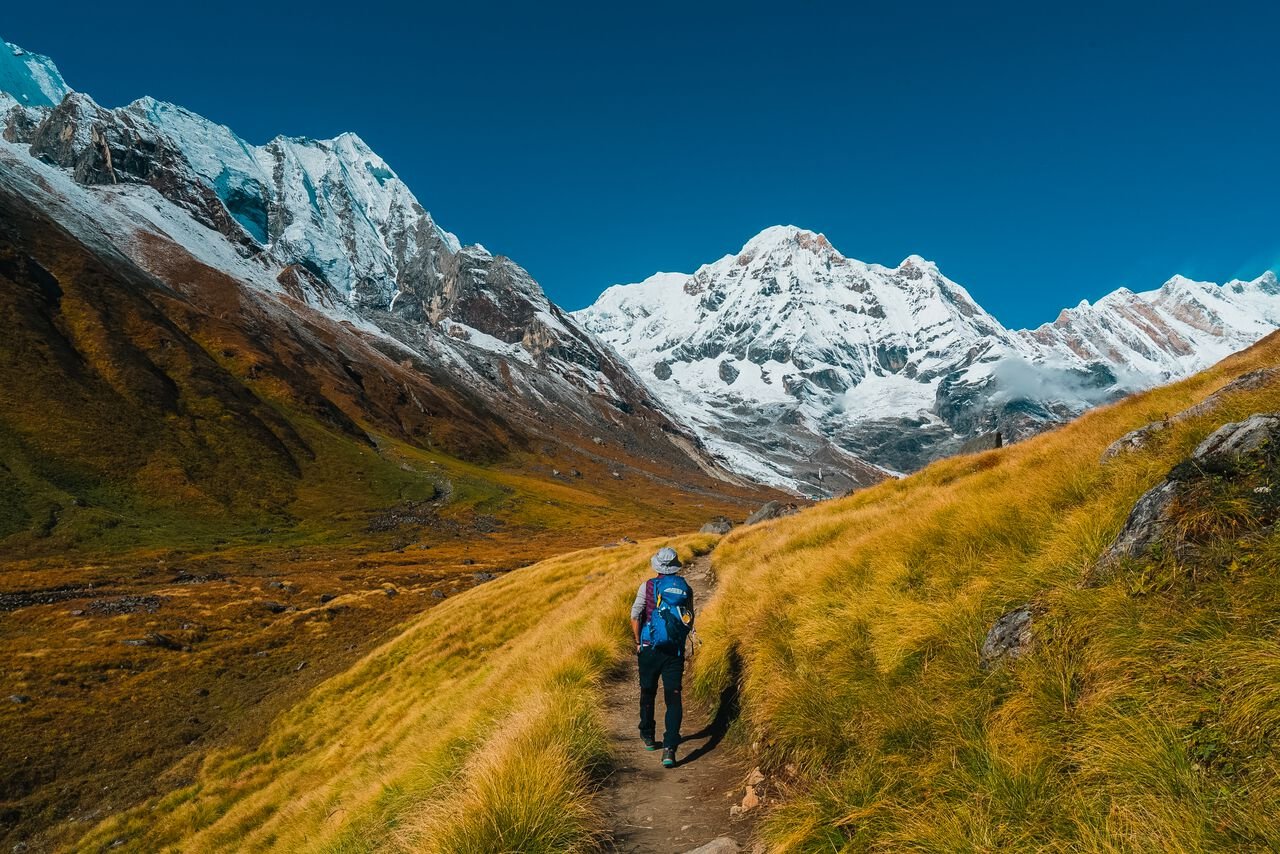Annapurna Base Camp Trek (7 Days-6 Night )
per person
Nepal is the country of the Mount Everest, the highest mountain peak in the world, and the Birthplace of Gautama Buddha- Lumbini. Mountaineering and other types of adventure tourism and ecotourism are important attractions for visitors.
The Annapurna Base Camp Trek is a journey of awe-inspiring natural beauty and cultural encounters in the heart of Nepal. Nestled within the Annapurna Conservation Area, this trek leads adventurers through diverse landscapes, from terraced fields and lush forests to high-altitude alpine meadows.
Trek Duration: The standard Annapurna Base Camp Trek typically spans 10 to 14 days, depending on the chosen route and acclimatization needs. However, shorter and more condensed versions are available for those with time constraints.
Best Time to Trek: The best times to embark on this adventure are during the spring (March to May) and autumn (September to November) seasons when the weather is pleasant, and the skies are clear.
Trek Difficulty: The Annapurna Base Camp Trek is considered moderately challenging, suitable for trekkers with a reasonable level of fitness. While the trek doesn’t involve technical climbing, it includes steep ascents and descents.
Permits: Trekkers are required to obtain the Annapurna Conservation Area Permit (ACAP) and the Trekkers’ Information Management System (TIMS) card. These permits help conserve the pristine natural environment and provide safety measures for trekkers.
Experience the Magic: The Annapurna Base Camp Trek is a magical journey that combines natural beauty, cultural richness, and the thrill of adventure. Whether you choose the classic route or a condensed version, this trek promises an unforgettable experience in the heart of the Himalayas
Discover the breathtaking beauty of the Annapurna region in just 7 unforgettable days. L K Holidays presents a condensed yet exhilarating journey to the Annapurna Base Camp, allowing you to experience the very essence of this iconic trek in Nepal.
Trek Essentials for Annapurna Base Camp Trek in Nepal: Your Complete Guide
Embarking on the Annapurna Base Camp Trek in Nepal is a dream come true for trekkers. The journey through diverse landscapes, charming villages, and breathtaking mountain vistas is an experience of a lifetime. To ensure a safe and enjoyable trek, it’s essential to be well-prepared with the right gear and essentials. In this guide, we’ll walk you through the basic gears, clothing, personal utilities, headgear, and footwear you’ll need for this incredible adventure.
Basic Gears:
- Backpack: A comfortable, well-fitted backpack is essential to carry your gear. Look for one with adjustable straps and good back support.
- Trekking Poles: These provide stability and reduce the strain on your knees, particularly during descents.
- Water Bottles and Purification: Staying hydrated is crucial. Carry reusable water bottles and a purification system to ensure safe drinking water during the trek.
- Sleeping Bag: Opt for a quality sleeping bag suitable for cold temperatures. Check the season and temperature rating.
- Trekking Boots: Sturdy, waterproof boots with good ankle support are a must. Ensure they are well broken-in before the trek.
Clothing:
- Layered Clothing: Dress in layers for temperature regulation. Include moisture-wicking base layers, insulating mid-layers, and waterproof outer layers.
- Trekking Pants: Lightweight, quick-drying, and convertible pants are versatile and comfortable for the changing terrain.
- Thermal Underwear: Pack thermal tops and bottoms for cold nights at higher altitudes.
- Warm Jacket: A down or synthetic insulated jacket provides warmth during chilly evenings.
- Rain Gear: A waterproof jacket and pants are essential to stay dry during unexpected rain showers.
Personal Utilities:
- First Aid Kit: Carry a basic first aid kit with essential items like bandages, antiseptic wipes, pain relievers, and blister treatment.
- Toiletries: Pack travel-sized toiletries, including a toothbrush, toothpaste, biodegradable soap, and toilet paper.
- Sun Protection: Sunscreen, lip balm with SPF, and quality sunglasses protect you from the strong mountain sun.
- Headlamp/Flashlight: A reliable headlamp or flashlight is essential for navigating teahouses and trails at night.
- Power Bank: Ensure your electronics, such as cameras and smartphones, stay charged with a power bank.
Headgear:
- Warm Hat: A warm, moisture-wicking hat is essential for cold nights and mornings.
- Sun Hat: A wide-brimmed sun hat shields your face from the sun’s rays.
- Buff/Neck Gaiter: Versatile for keeping your neck warm, as a headband, or as a face mask in dusty conditions.
Footwear:
- Trekking Socks: Invest in moisture-wicking, cushioned trekking socks to prevent blisters.
- Gaiters: These protect your lower legs and boots from dirt and moisture.
- Sandals: Lightweight, comfortable sandals are perfect for relaxing at teahouses after a day of trekking.
- Crampons: Depending on the season, crampons might be necessary for icy trails. Check with local guides.
Remember to pack light and prioritize essentials. Quality gear will enhance your trekking experience and ensure your safety and comfort along the way. Enjoy your Annapurna Base Camp adventure, and make the most of the stunning landscapes and rich culture that Nepal has to offer.
Annapurna Base Camp Trek: Your Ultimate Guide to Fitness and Health Precautions
Embarking on the Annapurna Base Camp Trek in Nepal is a journey of a lifetime, offering trekkers the chance to explore stunning landscapes, immerse themselves in local culture, and witness breathtaking mountain vistas. To ensure a successful and enjoyable trek, it’s essential to be in good physical shape and prioritize health precautions. In this comprehensive guide, presented by L K Holidays, we’ll cover fitness requirements and health precautions to help you prepare for this incredible adventure.
Fitness Requirements:
- Cardiovascular Endurance: The trek involves long hours of walking and steep ascents. Enhance your cardiovascular endurance by engaging in activities such as jogging, cycling, or swimming regularly.
- Strength Training: Strengthen your legs, core, and upper body to handle the demands of the trek. Incorporate exercises like squats, lunges, planks, and push-ups into your routine.
- Hiking Practice: If possible, engage in practice hikes in hilly or mountainous terrain to condition your body and improve your endurance. This will also allow you to break in your trekking boots.
- Altitude Acclimatization: The trek takes you to high altitudes. Consider acclimatization days and stay hydrated to prevent altitude-related illnesses. If you have any medical conditions, consult a healthcare professional before the trek.
Health Precautions:
- Vaccinations: Ensure you are up to date on routine vaccinations and consider vaccinations for hepatitis A, typhoid, and tetanus. Consult your healthcare provider or a travel clinic for recommendations.
- Travel Insurance: Purchase comprehensive travel insurance that covers medical emergencies, evacuation, and trip cancellations. Confirm that it’s applicable for high-altitude trekking.
- Water Purification: Only drink purified or boiled water during the trek to avoid waterborne illnesses. Carry a water purification system or iodine tablets.
- Food Safety: Consume cooked and hot meals, and avoid raw or uncooked foods. Ensure that the teahouses where you dine maintain good hygiene standards.
- Medications: Pack a basic medical kit that includes pain relievers, antibiotics, anti-diarrheal medication, and any personal medications. Consult your healthcare provider for altitude sickness prevention medication.
- Personal Hygiene: Maintain good personal hygiene to reduce the risk of infections. Carry hand sanitizer and wet wipes for situations where handwashing facilities are limited.
- Safety Measures: Follow safety guidelines during the trek. Stay on designated trails, hike with a guide, and inform someone of your itinerary. Be prepared for changing weather conditions.
Mental Health:
Trekking at high altitudes can be mentally challenging. Prepare yourself mentally by setting realistic expectations and staying positive. Take time to acclimatize and rest when needed. Surround yourself with supportive fellow trekkers and guides.
Remember that your health and safety are of utmost importance. Listen to your body, stay hydrated, and communicate any health concerns with your guide. With the right fitness level and health precautions, your Annapurna Base Camp Trek with L K Holidays will be a safe and unforgettable experience. Enjoy the breathtaking beauty of Nepal’s Himalayas and create lasting memories along the way.
- Spectacular Mountain Views: The trek offers breathtaking panoramic views of iconic peaks like Annapurna I, Annapurna South, Machapuchare (Fishtail), and Hiunchuli. The stunning mountain vistas evolve as you ascend deeper into the Annapurna Sanctuary.
- Cultural Encounters: Along the trail, you’ll pass through charming villages inhabited by various ethnic communities, including the Gurung and Magar people. Experience the warmth of Nepalese hospitality and immerse yourself in local traditions and customs.
- Diverse Landscapes: The journey begins in the subtropical lowlands near Pokhara and ascends through rhododendron forests and terraced fields. As you progress, the surroundings transition into alpine terrain, creating a rich tapestry of natural beauty.
- Annapurna Base Camp: The ultimate destination of the trek, Annapurna Base Camp (ABC) is a high-altitude sanctuary surrounded by towering peaks. It’s a place of serenity and unparalleled mountain views, making it a dream come true for trekkers.
- Warm Hospitality: The local teahouses and lodges along the trail provide comfortable accommodation and hearty meals. The friendly hosts ensure you feel welcome and well taken care of throughout your journey.
This 7-day adventure is the perfect choice for those seeking a condensed yet enriching experience of the Annapurna region, carefully crafted by L K Holidays to maximize the beauty and wonder of this iconic trekking destination.
What’s Typically Included in a Tour Package:
- Accommodation: Most tour packages include hotel or lodging arrangements for the duration of the tour. The level of accommodation (e.g., budget, standard, luxury or 5 star hotel) may vary depending on the package.
- Transportation: The package often covers transportation to and from the destination, such as flights, train tickets, or bus transfers. Local transportation within the destination, like guided tours or airport transfers,also included.
- Meals: Meals are usually provided as part of the package. This may include breakfast (at hotel ) and dinner ( Local restaurant or hotel) with the option for special dietary requests.
- Sightseeing: Guided tours and excursions to popular attractions and landmarks are often included in the package. With knowledgeable tour guides. ( according your language)
- Activities: Some packages include specific activities or experiences, such as adventure sports, cultural performances, or wildlife safaris.
- Itinerary Planning: Tour operators often design the itinerary, taking care of scheduling, reservations, and logistics.
- Airport Transfers: Transportation between the airport and the hotel is typically included in the package.
What’s Typically Not Included in a Tour Package:
- Airfare to the Starting Point: Unless explicitly stated, the cost of getting to the tour’s starting point (e.g., your home to the departure city) is not included.
- Optional Excursions: Some activities or excursions may be offered as optional add-ons and are not part of the base package.
- Entrance Fees: The cost of admission to museums, historical sites, and other attraction.
- Local Guides: In some cases, local guides or experts provide insights and information during tours.
- Travel Insurance Upgrades: While basic coverage may be included, travelers may need to purchase additional insurance for specific needs or higher coverage limits.
- Personal Expenses: Expenses such as souvenirs, personal shopping, alcoholic beverages, and spa treatments are usually not covered.
- Visa and Passport Fees: The cost of obtaining necessary visas and passports is typically the responsibility of the traveler.
- Tips and Gratuities: Tips for tour guides, drivers, and hotel staff are often not included and should be budgeted separately.
- International Departure Taxes: Taxes imposed by airports or countries upon departure are typically not included in the package.
- Medical Expenses: Non-emergency medical expenses, vaccinations, and medication costs are generally not covered.
- Baggage Fees: Charges for checked luggage or excess baggage are usually not included.
- Personal Transportation: If you want to explore the destination independently or deviate from the group itinerary, the cost of personal transportation is not covered.
- Anything which is not mentioned in inclusion.
It’s essential to carefully read the terms and conditions of a tour package to understand precisely what is included and what is not.
- DeparturePokhara
- Return TimeApproximately 8:30 PM.
- IncludeAirport TransfersDaily breakfast
- Not IncludedAccommodation in well-appointed hotelsDeparture TaxesAll applicable taxes and feesTransfers in comfortable vehiclesSightseeing tours with knowledgeable guides
Day 1: Pokhara (820m) to Tolka (1,700m) via Kande (1,770m)
- Your adventure begins in the serene city of Pokhara at an altitude of 820 meters. A picturesque drive takes you to Kande, situated at 1,770 meters, the starting point of your trek. As you embark on the trail, you'll notice the landscape gradually transition from the subtropical environment of Pokhara to the temperate zone. The day's trek takes you to Tolka, nestled at 1,700 meters. Here, you'll witness the first glimpses of the mesmerizing Annapurna Range and enjoy a peaceful evening.
Day 2: Tolka (1,700m) to Chhomrong (2,170m)
- Leaving Tolka behind, your journey continues through terraced fields and quaint villages. The village of Chhomrong, at an altitude of 2,170 meters, offers a warm welcome and a chance to experience the Gurung culture. The mountain vistas become even more spectacular as you approach Chhomrong, with the mighty Annapurna South dominating the scenery.
Day 3: Chhomrong (2,170m) to Dovan (2,600m)
- As you venture deeper into the Annapurna region, the trail leads you to Dovan at an elevation of 2,600 meters. The trek is characterized by dense rhododendron forests and lush vegetation. You'll be surrounded by the serene sounds of the Modi Khola River, creating a tranquil ambiance.
Day 4: Dovan (2,600m) to Machapuchare Base Camp (MBC) (3,700m) Today's
- Today's journey takes you to the Machapuchare Base Camp (MBC), positioned at 3,700 meters. This section of the trek offers breathtaking views of the iconic Machapuchare peak and its 'fishtail' shape. As you approach MBC, the grandeur of the Annapurna massif becomes more apparent, creating a truly awe-inspiring experience.
Day 5: Machapuchare Base Camp (MBC) (3,700m) to Annapurna Base Camp (ABC) (4,130m) to Dovan (2,600m)
- Your path leads to the Annapurna Base Camp (ABC), a high-altitude sanctuary nestled at 4,130 meters. Here, you'll be surrounded by towering peaks, including Annapurna I, Annapurna South, and Hiunchuli. The panoramic views of the snow-capped giants are a visual treat. After savoring the beauty of ABC, you'll retrace your steps to Dovan, descending through the lush forests and terraced fields.
Day 6: Dovan (2,600m) to Chhomrong (2,170m
- As you make your way back, you'll revisit the charming village of Chhomrong, located at an altitude of 2,170 meters. The descent offers a fresh perspective of the landscapes you encountered during your ascent. You can take in the cultural experiences and local life in a different light as you journey downhill.
Day 7: Chhomrong (2,170m) to Pokhara (820m)
- via Kimche The final day of your trek involves a descent from Chhomrong to Kimche, marking the end of your mountain adventure. From Kimche, you'll return to the lakeside city of Pokhara, located at an altitude of 820 meters. This is the time to reminisce about the incredible experiences and geographical diversity you witnessed during the Annapurna Base Camp Trek, from the subtropical lowlands to the alpine heights of the Annapurna Sanctuary.
Write a Review
| Deluxe Hotel Accommodation | Price Per Person |
| Travel Cost Based 2 to 3 Adult Per person Cost | 550 US Doll 45,500.Indian Rupees |
| Travel Cost Based 4 to 7 Adult Per Person Cost | 525 US Dollar 43500 Indian Rupees |
| Travel Cost Based on 8 to 11 Adult Per Person Cost | 500 US Dollar 41,500 Indian Rupees |
| Travel Cost Based on 12 to 20 Adult Per Person Cost | 475 US Dollar 39500 Indian Rupees |
| Book the Trip 30 Days Before Get | 10% Discount |
| Double Shared Room | Double Shared Room |




